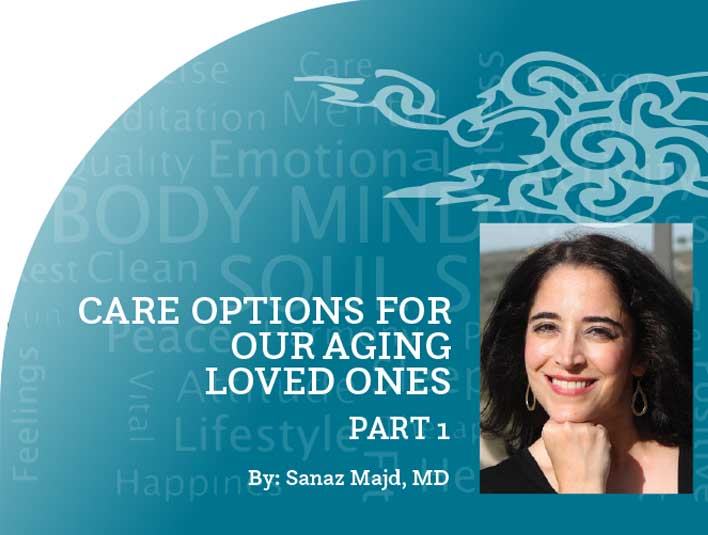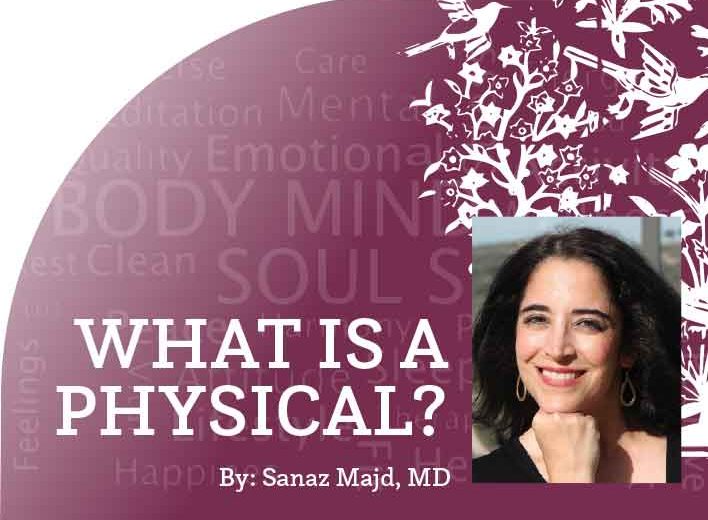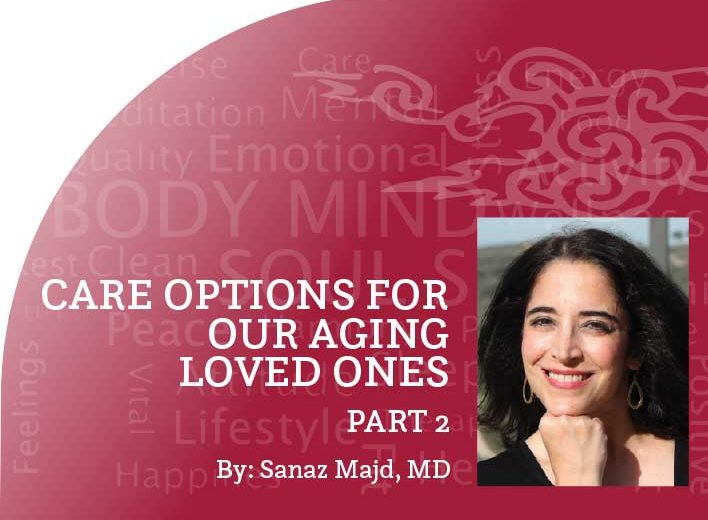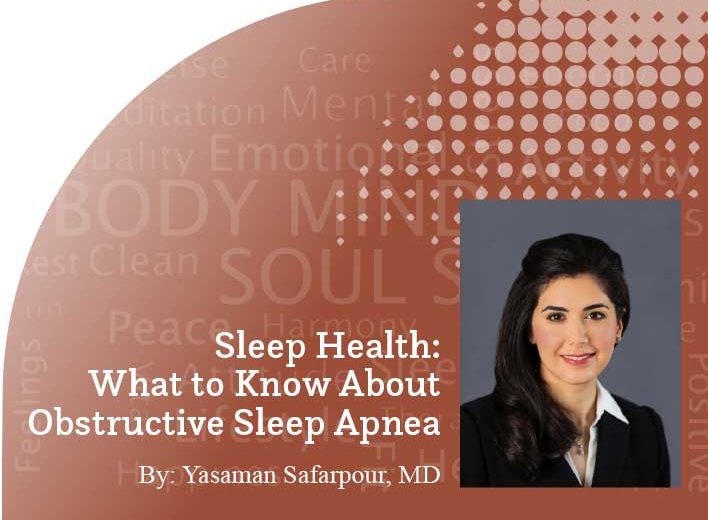CARE OPTIONS FOR OUR AGING LOVED ONES – PART 1
By: Sanaz Majd, MD
At an all time high of 79, the U.S. life expectancy has been steadily rising through the years, no doubt largely attributed to the great strides made in medical advancements—we now have antibiotics, vaccines, numerous research breakthroughs, and ways to prevent and treat the most common causes of mortality, such as heart disease and cancer.
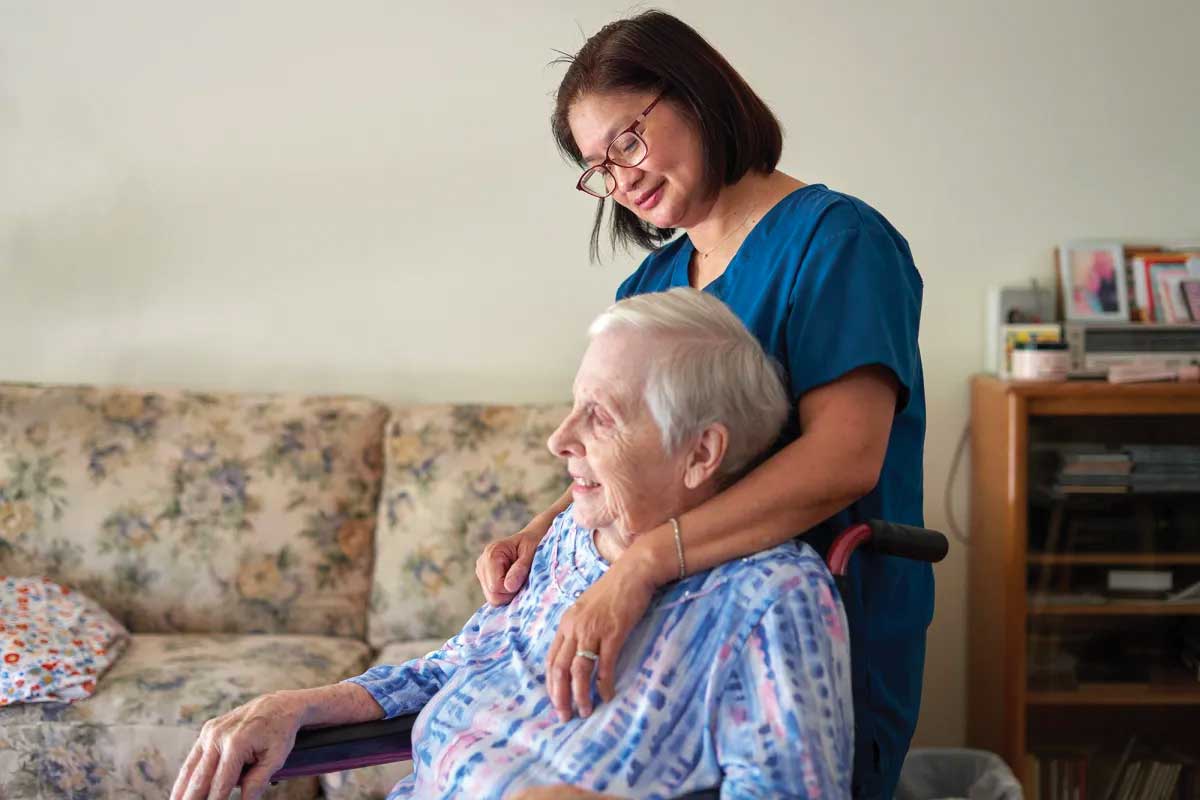
And the Baby Boomer population (born 1946 to 1964), with approximately 65 million people (hence, the term “Baby Boom”), is aging. By 2034, there will be 77 million people over the age of 65 in the U.S., a figure projected to reach 94.7 million by 2060. Many of these Baby Boomers are our aging parents, grandparents, and/or loved ones.
The truth is, with people living longer, it also means higher risk of developing dementia, mobility deficits, cardiac complications, etc. By the time we reach our 80s or 90s, the human body slows down in various ways and degrees. It may become more difficult to function and to perform seemingly simple activities of daily living, such as cooking, bathing, cleaning, and walking. Our loved ones may no longer be able to live safely on their own and/or will require greater assistance on some level.
What are your loved ones’ plans for the future? What are yours? We must be prepared for this stage in life, both for our own futures and for our loved ones. But unfortunately, the generation of Iranians who immigrated right after the revolution are not adequately prepared. After all, they are immigrants who turned their lives upside down by having to leave their beloved country, and were simply trying to survive and learn to assimilate. But by the time they have achieved that, they have found themselves in a bit of bind in their older age, without a plan or the funds to cover the costs of this stage in life.
The burden will lay on the shoulders of their children to figure it all out. This can be immensely stressful. For instance, what do you do if your parent now requires 24-hour care? More likely than not, you are a working adult living in the U.S., you have a family of your own and responsibilities of your own. You do not have the resources and time to take care of an aging adult 24 hours/day. And you may not have any other available family members who can.
If you haven’t had this discussion with your families, please consider it. Ideally, it is one to have with your loved one when they have capacity, the ability to make decisions for themselves, so that you can be prepared to carry on their wishes if that day ever comes. But if that time has passed and your loved one no longer has capacity, schedule a family meeting and come up with a plan as a team. There are important decisions to make and sometimes it may take a village.
This is a two part article. In this issue, we will review some of the top options and resources to help keep your loved one at home, which of course is ideal. And in the next Peyk issue, we will review the top out-of-home options if your loved ones’ needs cannot be safely met at home. Please pay attention to the references made to the “Resource” list at the end of this article.
I must preface this piece by saying that I am not a social worker and these articles are only for informational purposes. The information presented is solely based on my own research and experience. So, please, always seek guidance from your own expert sources. But I, too, have been down this road and have had many patients who have as well. My goal in this article is to help arm you with the knowledge that I wish I had from the beginning, for the options to be broken down and clarified instead of having to obtain bits and pieces of information from one social worker to the next. So, if I can help you navigate the complexities of senior care and prevent the confusion and feeling of helplessness during this potentially stressful process for even one of you, then I have done my job.
IN-HOME CARETAKERS:
PRIVATE AGENCIES:
If you are not aware, the cost of bringing in a 24-hour caretaker at an average hourly rate of $25-35 (currently in the year 2023) would be about $600 per day, or $18,000 a month minimum. Enough to bankrupt almost any family.
There are numerous licensed agencies who provide these services (see Resource #3 in the list below), albeit with hourly rates in the higher range of $35/hour (or more). It’s important to seek agencies that provide workers’ comp insurance (in case your caretakers get injured on the job) and perform thorough background checks on their employees.
Check out the San Diego Union-Tribune’s magazine called “Eldercare,” which is published twice a year and contains a comprehensive directory of in-home care, transportation options, health care services, financial support listings, etc., for aging adults. It can also be accessed online: www.SanDiegoEldercare.com.
CARE.COM:
Another resource for finding caretakers that come vetted and background checked is www.care.com. But here you decide how much you can pay and search for caretakers willing to accept the job. It can be hit or miss, but I have seen some patients for whom this has worked well. Just make certain to interview the applicants thoroughly and inquire if they carry workers’ comp insurance because, in this situation, you will now be the employer (and not an agency). What happens if they injure their back while lifting your loved one, slip on the living room rug and fracture their ankle, contract COVID from your household and develop a complication, etc.?
I recall a story of a home health phlebotomist. His hand got bitten by the dog belonging to the patient while he was drawing her blood at the patient’s home. The phlebotomist was out for months, requiring surgery. Thankfully, the home health care worker carried workers’ comp insurance. But if you find a caretaker on your own, you will have to consider this inherent risk. I’m only mentioning this so that you stay informed and be prepared for any employee who you bring into your private residence.
IHSS:
For those who are Medicaid eligible (in California, referred to as “Medi-Cal”), the In-Home Support Services (IHSS) program (#1) provides no-cost services for those who need help with their activities of daily living while still living in the home. It is a California State program, however other states may have similar ones.
One unique benefit of IHSS is that, if you are lucky enough to have a family member who is able to take care of your loved one, that carer can apply to become an IHSS employee and get paid for their time. You simply fill out an application online (#2), they come to the home to make an assessment, may send a form to your physician to complete, and grant the appropriate number of hours they feel your loved one will require.
The drawbacks of the IHSS program are:
If you don’t have a family member who can do the job, it is a great challenge to be able to find a non-family member to provide these services through IHSS. There are a limited number of available caretakers on their list, likely due to lower hourly pay than in the private workforce.
There may be some turnover of caretakers through time—caretakers may leave once they find higher paying job opportunities.
I have not seen IHSS grant 24-hour care.
HCBA WAIVER:
The Home and Community Based Alternatives (HCBA) Waiver Program is another Medi-Cal covered service that provides extra care beyond IHSS for those who would otherwise require admission to a nursing care facility, with a mission to help keep more people at home. In other words, if your loved one requires more hours than IHSS can provide in order to keep them from having to move into a nursing home, the HCBA program is an added option if your loved one has Medi-Cal. The application can be downloaded online and emailed/faxed (#4). However, the combination of IHSS and HCBA services may still not add up to 24 hour care if needed.
IMPORTANT CARETAKER CONSIDERATIONS:
Note that, depending how functional your loved one is, there are a few potential drawbacks of hiring a caretaker:
They may not all be reliable—they may be late, their car may break down, they might not show up, they may call off at the last minute, they may not feel comfortable performing certain tasks, or they may not complete the tasks as thoroughly as you would like them to, etc.
They cannot work 24 hours a day—that means you will need to hire several caretakers to take shifts.
They may not work weekends—you will need a different team for weekends.
They may call out sick—that means you will need to have a back up plan or stay home with your loved one yourself.
You will be required to give vacation time—that means you will need a back up plan for those weeks.
They may find a different job opportunity and leave—that means you will have to search for another caretaker, and fast if you yourself work.
If it is difficult to find a backup plan to care for your loved one in these instances, it may be worthwhile to consider out-of-home options for your loved one to be safe and cared for.
OUT-OF-HOME CARETAKERS:
ADULT DAY CARE PROGRAMS:
Instead of hiring a caretaker for 8 hours a day, another option is to enroll your loved one into an adult day program. Some of these day programs may have a fee, but are often much less than having to pay out of pocket for an in-home caretaker. They often offer full-day and half-day rates. There are often nurses on-site to administer medications, included meals, structured activities, and even transportation. If you have Medi-Cal, transportation to/from may even be covered.
For those with Medi-Cal, the Community-Based Adult Services (CBAS) program (#7) helps cover the cost for these adult day care services if needed. And some of the facilities are dedicated to those with memory impairment; their activities are therefore structured appropriately towards that population.
For a complete list of adult day programs in San Diego, check out Resource #6.
SAMPLE CARE SCHEDULE COMBINING SERVICES:
If your loved one is Medi-Cal eligible, one particular plan of action may look like this:
9:00 a.m.-5:00 p.m.: Adult Day Care
5:00 p.m.-10:00 p.m.: IHSS
10:00 p.m. to 9:00 a.m.: Out-of-pocket in home caretaker or none if your loved does not require 24-hour care
MULTIPURPOSE SENIOR SERVICES PROGRAM:
The Multipurpose Senior Services Program (MSSP) assigns case managers who will coordinate services for Medi-Cal eligible, frail seniors who are at risk for placement outside the home. They are basically social workers who are assigned to help you receive the above services so that your loved can continue to stay in the home (#8). It may be a good place to start if all of this is overwhelming and/or you need some extra assistance applying for some of the services discussed in this article.
In The Next Issue:
Remember that when determining a plan for your loved one’s care, their safety is always a priority. And if they are safe at home and you are able to make it work, that is of course ideal. But if their safety is compromised at home, it may be appropriate to explore out-of-home options.
In Part 2 of this article, I will review some of the options for assisted living and memory care facilities, and review how to apply to programs that will help pay for the cost for those who have Medicaid, along with a few other pertinent topic considerations for aging adults.
RESOURCES:
KEEPING YOUR LOVED ONE AT HOME:
1. In Home Support Services (IHSS): https://www.sandiegocounty.gov/content/sdc/hhsa/programs/ais/Services/In-Home-Supportive-Services.html
2. IHSS Application: https://www.cdss.ca.gov/Portals/9/FMUForms/Q-T/SOC295.pdf
3. List of certified caretaker agencies: https://tinyurl.com/ynhcnxcs
4. HBCA: https://www.syhealth.org/services/hbca-waiver-program
5. Southern Caregiver Resource Center (SCRC): services to family caregivers of adults with chronic/disabling conditions (such as dementia, stroke, etc.) scrc@caregivercenter.org, 858-268-4432
6. Adult Day Programs: daycare programs for elderly adults https://sandiego.networkofcare.org/content/client/4/Community-Based-Adult-Services.pdf
7. CBAS care centers: https://aging.ca.gov/Providers_and_Partners/Community-Based_Adult_Services/CBAS_Providers/
8. MSSP: social and health care management services to assist frail individuals aged 65 or older to remain in their own homes and communities https://www.sandiegocounty.gov/content/dam/sdc/hhsa/programs/ais/docs/MSSP-Flyer-English.pdf
9. San Diego & Vista, Program of All-Inclusive Care for the Elderly (PACE): https://www.syhealth.org/san-diego-pace-services
10. Partner in Aging: https://tinyurl.com/5cunf8zh
HEALTH INSURANCE GUIDANCE:
11. Health Insurance Counseling and Advocacy Program (HICAP): free, unbiased Medicare & health insurance counseling (for instance, if you are nearing age 65 and wondering which Medicare HMO plan to select) 858-565-8772
12. Legal Aid Society: pro bono attorneys that provide free health legal guidance 877-734-3258
13. Elder Law Advocacy (ELA): legal and Medicare guidance https://elaca.org/
DEMENTIA SUPPORT:
14. Alzheimer’s San Diego: alzsd.org 858-492-4400

